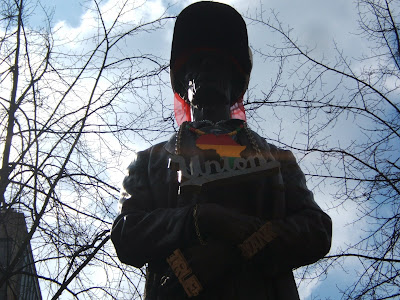 Lincoln Square has turned into an unlikely tourist attraction, with a crowd of people holding their mobile phones up to get a picture of Abraham Lincoln gone bling. The statue that gives the small square on Brazenose Street (incidentally, one of my favourite street names) its name hitherto only stood out for its unusually large head. Now, the head has been accentuated even more by a puffed up 'NY' New York Yankees style hat with red cloth of an indeterminate purpose trailing out of it. A grave looking President Lincoln also sports some hip-hop bling around his neck, including a large gold medallion proclaiming ‘Union’ (as in, the Northern states of the Union versus the secessionist Southern States, back in American history). To top it all off, he’s given a bit of street attitude by large rings almost the size of his hands which tell us he’s a ‘true Yank’. The effect is as comical as you can imagine.
Lincoln Square has turned into an unlikely tourist attraction, with a crowd of people holding their mobile phones up to get a picture of Abraham Lincoln gone bling. The statue that gives the small square on Brazenose Street (incidentally, one of my favourite street names) its name hitherto only stood out for its unusually large head. Now, the head has been accentuated even more by a puffed up 'NY' New York Yankees style hat with red cloth of an indeterminate purpose trailing out of it. A grave looking President Lincoln also sports some hip-hop bling around his neck, including a large gold medallion proclaiming ‘Union’ (as in, the Northern states of the Union versus the secessionist Southern States, back in American history). To top it all off, he’s given a bit of street attitude by large rings almost the size of his hands which tell us he’s a ‘true Yank’. The effect is as comical as you can imagine.Obviously noone told the MEN, who in today's edition said “mystery surrounds who has given the statue the makeover”, that the stunt wasn't a work of an anonymous graffiti artist. It’s the doing of the American street artist Leon Reid IV and was commissioned by URBIS as part of their exhibition State of the Art: New York, which starts next week and will celebrate the city's vibrant art scene.
An interviewee in the same article - who is clearly completely devoid of a sense of humour - said: "I'm not quite sure what it's supposed to say. It's supposed to be modern art. They've turned it into some kind of African gangster statue. I don't particularly like it. It looks very strange. Apparently they had a crane. I don't like it. It's insulting. I think it looks really daft."

He’s spectacularly missed the point. The African map hanging from his neck is a reference to Lincoln’s work to stop the slade trade during the American Civil War of the 1860s.
Lincoln was supported by Manchester in his opposition to the slave trade - yet another example of Manchester as a politically radical, forward thinking city, which is why there is a statue of Abraham Lincoln in Manchester in the first place.
Or maybe he's choosing not to see the point, seeing as we're also told this at the bottom of the statue, which acknowledges ‘the support that the working people of Manchester gave in the fight for the abolition of slavery during the American civil war'.

The statue was placed in the square in 1986, in a fairly tucked away location (considering Brazenose Street's proximity to the Town Hall and the prominence of the statues in Albert Square).
I, for one, had to do a double take when I went to the Post Office on Brazenose Street this afternoon. It definitely brightened up my grey afternoon as well as, I'm guessing, that of the office workers who eat lunch in the square every day. It's a thought provoking bit of modernisation, and you can't ignore the influence the past has had on our times.
www.urbis.org.uk/page.asp?id=3280
You may also enjoy Jonathan Schofield's article on the history of the statue, which was written to coincide with Barack Obama's election as president.
Additionally, the comments on the MEN website are pure gold, as ever, notably Squirrelito:
"the only link I can see between Lincoln and Hip Hop "culture" is that so many gangsta rappers were also shot dead.
Hip Hop culture?
Judging by the arc that Hip Hop has taken over the last 30 years, are we also to assume that Mr Lincoln started out as charting social conscience and decrying the plight of the black man in America but over the years became more interested in perpetuating the stereotype of the violent, money-obsessed, misogynist homophobe?
Very uplifting
squirrelito,
31/03/2009 at 15:46"











